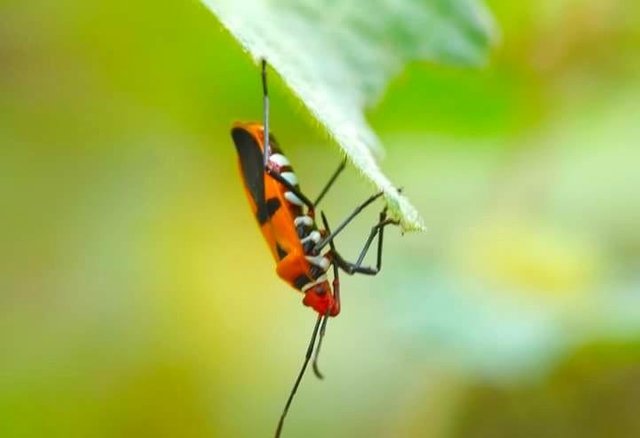Why Popular
Most of these friendly little beetle species are eager to eat aphids (visible on the left), soft-bodied insects that suck crops and feces that wither and die. Some adult breeds can eat thousands of aphids during their lifetime, and female larvae are equally voracious. After all, these beetles eat a lot of other insect pests, and some even like pests that damage crops around the farmers' fields.

!
A Year of the Ladybug Life
This charming little beetle is like a dome, round or oval, with a flat stomach. Although greedy, most species of ladybugs are less than a centimeter long. The flying-wing is frail and sheltered behind the elytra, which is a shiny wing cover that gives colorful beetles of its pattern. As the insect flies, it is completely open so it does not block the wing-fly. Although ladybirds are often depicted red with black spots, about 5,000 species of ladybugs actually have a variety of color combinations and spots. There are orange or yellow with dark spots. The other is black with red spots. Some are not spotted. There are others that are chipped like chess or striped boards.
Many species of life reach a year. During the winter, the adult ladies are hibernating in a dry, sheltered location. When the weather is hotter, they wake up and fly in search of plants infected with aphids. The female ladybug, after mating, puts a small yellowish egg (visible on the right) on the underside of the leaf near the aphid colony. Each egg hatches into a six-legged larva which is more like a small, gluttonous aligator (left visible) than a mature bugger. Because all the time it eats aphids, the larvae soon become too big for the skin. After changing the skin several times, he attaches himself to a plant and produces a pupal shell. In the cocoon, the larvae continue to grow until it finally comes out as a mature bugger. When his body is still soft and pale, he sticks to the plant until his body hardens. Within a day, a typical pattern emerges.
The enemy gets a lesson to avoid the colorful ladybugs. When threatened, the beetle sprayed a foul-smelling yellow that tasted disgusting from the joints. Predators, like birds or spiders, will never forget their first unpleasant encounter, and the insect's bright colors will always remind them to keep their distance.


In the world of insects there is one species of ladybird, which was originally used as a pest exterminator, even a destructive pest. Harlequin ladybugs, also called Asian colorful pistils, live harmoniously with other species of ladybirds in their natural habitat in northeastern Asia. Due to strong interest in aphids and other plant pests, recently he was brought to North America and Europe. Unfortunately, he even threatens the survival of the local ladybirds by eating all their food. Worse, when his favorite food is gone and no natural enemy controls the number the hungry beetle begins to devour the local ladybirds and other useful insects. Entomologists view the future with pessimism as they anticipate the extinction of some species of ladybirds. Harlequin ladybugs are also unpopular as they devour ripe fruits ready for harvest and for clustering around houses to avoid the winter air that can make him die. Then some other species of ladybirds devour valuable crops instead of insect pests. But there is also a type of ladybird that is considered safe for agriculture.




World of Photography
>Visit the website<
You have earned 6.50 XP for sharing your photo!
Daily photos: 1/2
Daily comments: 0/5
Multiplier: 1.30
Block time: 2018-07-02T02:26:18
Total XP: 294.85/200.00
Total Photos: 48
Total comments: 0
Total contest wins: 0
Follow: @photocontests
Join the Discord channel: click!
Play and win SBD: @fairlotto
Daily Steem Statistics: @dailysteemreport
Learn how to program Steem-Python applications: @steempytutorials
Developed and sponsored by: @juliank
Downvoting a post can decrease pending rewards and make it less visible. Common reasons:
Submit
Thank you for your contribution to the Photocircle tag!
Cheers,
@photocircle Team
Learn about this photo curation project by clicking >here
Downvoting a post can decrease pending rewards and make it less visible. Common reasons:
Submit
Wow... Si kepik yang cantik. Tapi sayang dis dimusuhi oleh petani
Downvoting a post can decrease pending rewards and make it less visible. Common reasons:
Submit
Little red... 👍👍👍
Downvoting a post can decrease pending rewards and make it less visible. Common reasons:
Submit
Good post...
Downvoting a post can decrease pending rewards and make it less visible. Common reasons:
Submit
Postingan yang keren...
Downvoting a post can decrease pending rewards and make it less visible. Common reasons:
Submit
Kumbang kecil yang menjadi mainan anak-anak
Downvoting a post can decrease pending rewards and make it less visible. Common reasons:
Submit
Congratulations @syuhada: this post has been upvoted by @minnowhelpme!!
This is a free upvote bot, part of the project called @steemrepo , made for you by the witness @yanosh01.
Thanks for being here!!
Downvoting a post can decrease pending rewards and make it less visible. Common reasons:
Submit